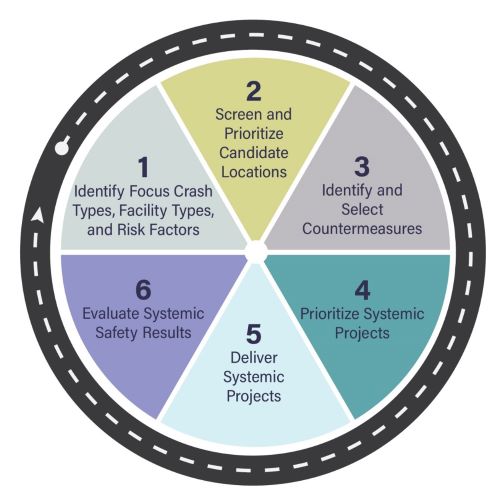Systemic Approach to Safety
Supporting the Principle: Safety is Proactive
Using the systemic approach to perform data-driven safety analysis supports the Safe System Approach principle: Safety is Proactive. The systemic approach is a fundamental component of a comprehensive approach to safety management. It can be used to develop Comprehensive Safety Action Plans, Strategic Highway Safety Plans, and other safety action plans. This approach can identify opportunities to install Proven Safety Countermeasures to effectively reduce fatalities and serious injuries at scale.
The Systemic Safety User Guide (coming soon) is a substantial update to the Federal Highway Administration’s Systemic Safety Project Selection Tool, published in July, 2013. Since the introduction of the systemic approach to safety, transportation agencies, at all levels of government, have made tremendous strides incorporating this analysis as part of their comprehensive safety management strategies. A systemic approach continues to be a fundamental component of how agencies determine proactive and cost-effective approaches to improve safety throughout their transportation system.
The Systemic Safety User Guide covers the six-step process of applying the systemic approach along with noteworthy practices, tips, frequently asked questions and case studies from a variety of agencies.

Systemic In Practice
Several transportation agencies are using the systemic approach to safety and achieving results. Visit the following noteworthy practices and case studies that illustrate these applications.
- Boone County’s Local Road Safety Plan (NEW)
- Illinois
- Kentucky
- Louisiana
- Minnesota
- Missouri
- Nebraska
- New York
- Ohio
- Ohio’s Machine Learning Profile Analysis for Roadway Departure and Pedestrian Crashes (NEW)
- Thurston County, Washington
Access the full Noteworthy Practices Database or submit your practice to the database.
Resources
- Additional resources coming soon.
- The Systemic Medical Analogy: How Healthy is Your Road System?
- Video: The Systemic Approach - Preventative Medicine for Roads
- Application of DDSA for a Systemwide Safety Risk Assessment: A How-To Guide (coming soon)
- Federal Lands Highway's Development of Safety and Traffic Data Collection System and Analysis Framework for Federal Lands (coming soon)
- Visit this link for a list of potential risk factors a state or local agency might consider with the systemic safety approach.
- The previous 2013 Systemic Safety Project Selection Tool publication is available for additional reference.
Training
- Updated recorded training is coming soon.
- A one-day workshop is available upon request by the FHWA Resource Center. Contact Derek Troyer and Matt Hinshaw for interest.
